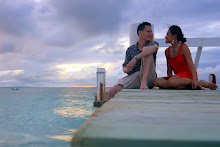Our bus travels “north” 6 hours on the Pan-American highway to David, where we change to a yellow sixties era school bus, for a one hour trip up the foothills to Boquete. Boquete offers an interesting mix of pleasant sub-tropical weather, friendly locals, coffee plantations, adventure activities, and retired gringos in gated communities; apparently AARP listed as a new hot spot.
We are happy to find everything located within a few blocks. We stay at the Boquete Hostel, a really pleasant and relaxing spot overlooking the river. There’s nothing quite like a good night sleep to the sounds of the flowing water, then waking up with a glass of freshly squeezed OJ, and a locally grown coffee.
Today we take a fascinating coffee tour with Café Ruiz; fascinating for us because coffee is one of the biggest commodities in the world that we know almost nothing about. The tour visits the three places of coffee production;
1) plantation,
2) processing plant
3) roasting facility
On the plantation, we pick some ripe fruit (yes, coffee is a fruit) and are fired immediately. We try several times but just can’t get the right twist and pull motion to pick the fruit without damaging the stems. We are surprised to find the fruit tastes quite delicious. Perhaps if the seed wasn’t so big and smelled so nice during a forest fire some time back in Ethiopian history, then we might be drinking coffee juice with breakfast. At the processing plant, we learn about what it takes to ready coffee for export;
• Picking (October – March)
• Floating: to detect seeds with air from bugs
• Squeezing: to separate the fruit from seeds
• Fermentation: to remove the sticky sugars on the seeds (only 24 hrs)
• Washing: to remove the skins and fruit from the seeds
• Pre-drying (3 hrs)
• Drying (36 hrs)
• Aging (4-6 months)
• Peeling: to remove the two layers of skin
• Sorting by density, color, shape, size; required for accurate roasting
Although Café Ruiz exports 90%, we visit their small roasting facility to learn about the final step; roasting light, medium, and dark roasts for 16-24 minutes (aka; European, Latin, Italian, and French roasts). In our guide’s opinion, European roast is the best, as the dark roasts burns the beans, and ruins the flavor.
Unfortunately, the tasting part of the tour was disappointing. We tried light, medium, and dark roasts to detect their subtle differences. But, the coffee brew was weak, and didn’t smell fresh. In the end, it seems quality water and fresh preparation is more important than anything else.
Nov 11, 2009 Boquete, Panama
Today, we take a Jeep tour to visit the nearby cloud forest, and see the local sights. Surprisingly, the most interesting part of the tour is a visit to a small independent coffee farm run by a cheerful fellow named Tito. Our tour runs several hours over schedule as we bombard Tito with questions about his farm. Why grow eight varieties of coffee if this one is the most productive? If they all taste different, why blend the varieties?
We ask him about organic farming. He says a lot of farmers are interested, but it is impossible now, because organic coffee doesn’t get a higher price in Panama.
Tito is proud to show us his homemade machines. Next to his roaster, he shows us a spoon wielded to a flathead screwdriver that he uses; “muy importante!”. We roast a small batch of beans, and snack on a few, before drinking some fresh brew.
 Tito teaches to differentiate the varieties. Guessha (considered to be the best) grows somewhat erratically.
Tito teaches to differentiate the varieties. Guessha (considered to be the best) grows somewhat erratically. Drying the beans while separating into 3 classes: best quality, good, and so-so. Take a guess which is which!
Drying the beans while separating into 3 classes: best quality, good, and so-so. Take a guess which is which! back at the hostel, Kevin pre-drying his seven hand picked beans. Results? Coming Next!
back at the hostel, Kevin pre-drying his seven hand picked beans. Results? Coming Next! CLICK HERE to see more Boquete pictures.





























1 comment:
笑笑, 凯文:
非常高兴又看到你们这么多丰富多彩的照片, 照片都拍得很好, 很多美景, 和有趣的画面,凯文跳探戈的表情很酷,象西部牛仔. 三人行一定学到更多的东西吧.
爸爸11/18回LA, 碎结石的手术作得很好, 爸爸精神也很好. 我们和吕曦, 付勇合资买下一个小店, 准备做面食店, 这几天正在
清理和装修这个店, 在感思节那天开业, 所以这几天都忙到很晚才回家. 爸爸有个事情做也好, 这也是他喜爱做的事, 我自已的工
作还是坚持做, 不会放弄. 只是帮他们管理财务, 有空去帮帮忙.
替我们问候Erine和凯文的弟弟夫妻两人, 也祝福他们新婚愉快, 生活永远甜甜蜜蜜, 和幸福.
感思节快乐!
Post a Comment